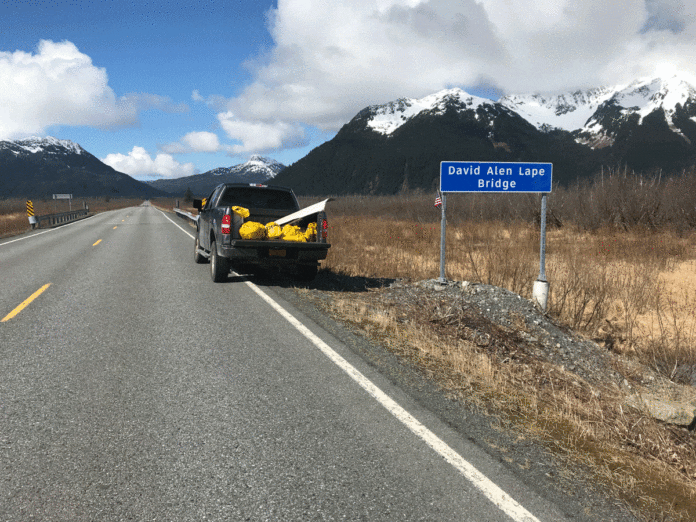
Inspired by Roy Srb’s Don Quixote-style battle against trash along the Copper River Highway, many years ago I joined the quest for the Impossible Dream — a litter-free byway.
After all, “out the road” is half the reason many of us live here and keeping it clean and pristine should be everyone’s goal. A recent photo essay in this paper by Emily Mesner about Cordovan’s favorite pastime identified many of its joys, especially on our first bright spring day.
And imagine the eager anticipation, and then disappointment, of migrating waterfowl traveling thousands of miles to their nesting grounds, only to find them despoiled by trash. Picture Dusky Canadian Geese, unique to this Delta, dodging beer cans in their morning quest for roadside gravel. Maybe that’s why they honk so much.
Crazy at it may seem, picking up trash along the highway early in the morning has its rewards. Crisp fresh air, countless variations in sunrise, pairs of geese zipping by, ducks quacking, swans trumpeting, moose splashing through marshes, the occasional howls of coyotes, beavers, bears, an incredible variety of trills from songbirds, and the realization that so many people miss the best part of each day.

Photo by Dick Shellhorn/The Cordova Times
Rather than double up, early on Roy and I reached an agreement to divide our forces, and somehow, I ended up with the better part of the deal, volunteering to work the highway from Mile 7 on out. My request was motivated by a life-long love of waterfowl; and in hindsight, my partner really got the raw end of the deal, as there is much more trash closer to town.
Anyhow, last week, while mindlessly working on the edges of the road, it dawned on me that this is Year 20 in our combined war on waste; and that this effort could also be viewed as a long-term, AKA longitudinal study, of Cordova’s littering habits.
Here are some findings, based on empirical data:
- Empty beer cans have replaced bottles as the favorite to toss out the car window.
- Bud Light remains the polluters’ brand of choice, although Coors Light is now a close second.
- People are smoking much less, while consumption of bottled water and coffee has skyrocketed.
- Styrofoam, especially the larger “cell” type found in inexpensive white ice chests, still is one of the worst pollutants. It breaks into small pieces and never decays.
- The most trash is now found near Ibeck Creek, where large numbers of sport fishermen congregate each fall. Twenty years ago, this silver-salmon combat zone barely existed.
- The amount of trash “below,” or on the south side of the road, is almost double the amount “above” the road, due to the prevailing winds that often blast down the river beds from the Scott Glacier.

Photo by Dick Shellhorn/The Cordova Times
On the bright side, several positive trends have developed:
- There is much less industrial-type trash along the highway. The city crews that truck waste to the landfill at Mile 17 are doing a far better job of covering their loads, as are construction firms that use the landfill, and canneries that hurry to take fish to the Mile 13 airport.
- Individuals are being much more careful about waste blowing out of their vehicles, and especially the backs of trucks. As a result, there are far fewer plastic bags along the road, which are a particular distraction as they snap in the breeze when caught on branches.
- More volunteers, including Glenn Ujioka (highway), Adam Kenyon (Hartney Bay campground), and Kelly Weaverling (Orca Road) have joined the campaign.
- And the battle is being won. People are becoming more aware and considerate.
It is said that numbers don’t lie, and a daily count of the number of yellow trash bags I have filled per mile this year is almost half of what it has been in the past. So far, from Mile 7 to Mile 13 the total is 42; in year’s past it was often 100 or more.
The decline was so surprising I asked several people that drive the highway daily, including State DOT workers, TSA and Alaska Airlines employees, plus John Wiese and Brent Songer, who bike from Mile 6 out the road for exercise early each morning, if someone had already cleaned up the highway. They all answered no.
And equally amazing: A drive down Alaganik Road yielded a grand total of one beer can and one beer bottle, plus not a single pothole, thanks to the crowning of the road by the USFS last summer.
Several years ago, a passer-by stopped to thank me for picking up trash, and discreetly tried to find out why I was doing Community Service Time.
That was good for a chuckle, and I replied that the geese had pressed charges.
Thanks to the combined efforts of Cordovans, both they and us are winners.
Awesome.
Note: The Chamber of Commerce City Cleanup Day is scheduled for May 25. Many hands make light work. And a trick of the trade: bring a roll of black electrical tape to seal the top of the bags shut.














